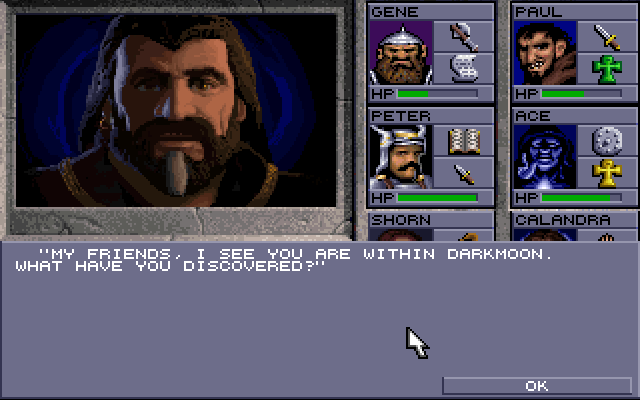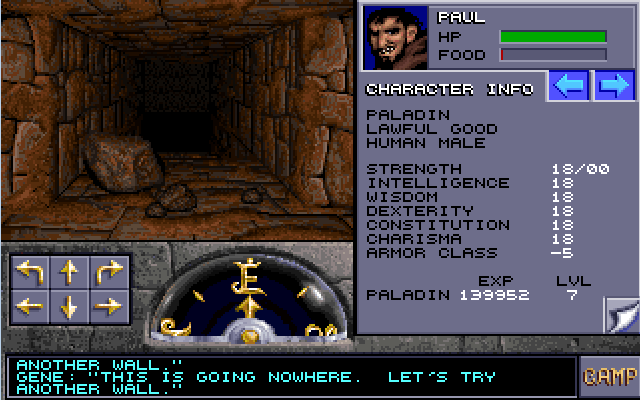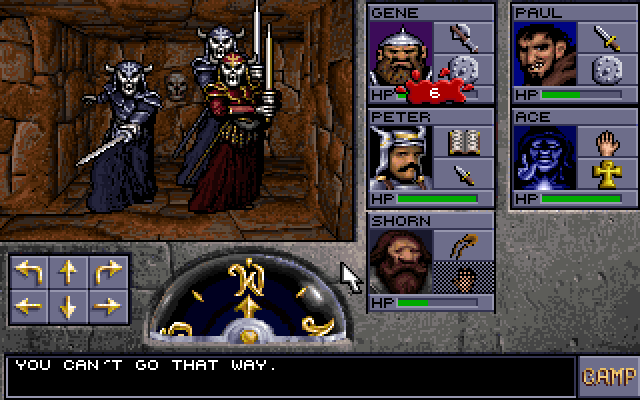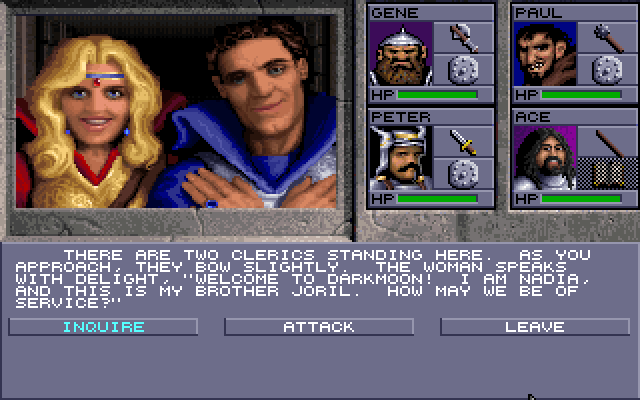Can't Find Draw in Eye of the Beholder Game
Why you should play Eye of the Beholder 2 from GOG's D&D collection

GOG demands ten bucks for the new Eye of the Beholder bundle—technically Forgotten Realms: The Archives Collection 1—which, thanks to the cratered Canadian dollar, comes closer to $14 for me. That's fine. I've been waiting for this moment for too long to worry about trivialities like money. After GOG added the Forgotten Realms bundles a few weeks ago, we wrote about how they rescued 13 D&D classics from licensing hell. Some of them were great RPGs in their day, and I'm glad to see them preserved today. But they're not just museum pieces. Two decades later, my favorite of the bunch feels just as vital as it did when it was new.
I played Eye of the Beholder 2: The Legend of Darkmoon when it came out, back in 1992, and it was pure magic—a great dungeon crawler, and perhaps more significantly, far and away the single best D&D experience ever created for a PC, a title it would hold until Baldur's Gate came along. In my memory, it's still top five stuff, maybe even top three. Hell yes, I'm playing it again.
There are two other games in the Eye of the Beholder series: the first, Eye of the Beholder, and EOB3: Assault on Myth Drannor. The original is good, but it's essentially Baldur's Gate to the Baldur's Gate 2 that is Legend of Darkmoon. Environments are less interactive, and there's only one save slot. Myth Drannor, on the other hand, was built on a more advanced version of the game engine and is thus more technically adept, but it wasn't developed by Westwood, and the change really shows: It lacks the focus, depth, and magic that made Darkmoon so good. Characters can be imported from one game to the next and that would certainly add up to a remarkably epic dungeon crawling experience, but it would take more dedication than I bring to the table to get through it.
The EOB2 download is a lot bigger than I expect, around 50 times the size of the original, which fit on three 720K 3.5 inch floppies, but it's done in relatively short order. I click the play button in GOG Galaxy—which, by the way, is fantastic—and, after a quick heads-up on the DRM workaround, I'm thrown a quarter-century into the past, to one of my favorite videogame intro sequences of all time. (Seriously, check it out. It still gives me goosebumps.)

My companions and I are in an inn, settling down for a quiet night, but fate has other plans. Khelben Blackstaff (with whom I am tight, having done a big solid for Waterdeep in the previous game) wants to see me. Up the spiral stairs we go, into his magnificent chamber, where he gives us the lowdown: Trouble's afoot in Temple Darkmoon, his scout is missing, and he's sending in the ringers. He gives me a coin, a hearty slap on the back, and we're off. The music swells and for just a a moment, my heart beats faster. Chewie, we're home.
Of course, "we" don't technically exist until I spend some time with the character creation menu. Throughout the process of building my crew, I am thankful that SSI included a proper rule book with the game, and that GOG bundled a scanned copy (and a scan of the hint book as well) in its version. Character builds are everything in Eye of the Beholder, and there's no space for witty conversationalists or weakling weirdos with preternatural luck. Adventuring parties must be smooth-running machines, efficient in every way, and the manual breaks down the benefits and disadvantages of single and multi-class characters, racial bonuses, and more.
It takes me a few tries, and some early-game ass-kickings, before I come up with a team I like: a fighter, a paladin, a mage, and a cleric/thief. I could probably live without a thief, but I decide that the paladin's "Lay Hands" healing ability, basically a Cure Light Wounds spell for people who don't know magic, will help balance out the knock against my non-specialist cleric—and there are few things that drive me crazy faster than a videogame door I can't unlock.

Despite my preparation and liberal abuse of the "modify" button, which lets me crank up every character stat to its max (trust me—use it, and don't feel guilty), fights are punishing, even in the early-stage catacombs. I spend literally days of game time resting, healing, and readying my party for the next encounter. It seems so strange now, but in AD&D, spells are "forgotten" once cast, until the caster rests for a full eight hours. And with healing potions so bloody rare, and crafting not an option, most of the time it's just my lone cleric, Ace, casting and resting repeatedly until we're ready to move on. Fortunately, nobody in the temple seems to notice or care, and even after a solid three-day camp out, I can pick up and move on like only a minute or two has passed.
On the second level of the catacombs below the temple, I come upon a familiar locked door. I open it, and skeletons pour out, as I knew they would, accompanied now and then by Darkmoon clerics. A stand-up fight is suicide, so I do what we did back in the day: I stick and move, sliding sideways, taking a swing, then slipping back in the other direction for another strike.
When things get out of control, I haul ass down a long hallway, luring a group of them into a room that I lock behind us. Slide and swing, slide and swing, and then draw in another group and do it again. Over and over I do this, and after 30 minutes I'm getting tired and a little bored and I'm really starting to wonder how many goddamn skeletons there can possibly be in this room, when suddenly, it gets quiet. No footsteps. No sounds. Nothing. I venture back to the room where this nightmare began, encountering no resistance along the way. I reach the door. I wait. Silence. Daring to hope, I enter and turn to my right.
Skeletons.

Ten more minutes of "mopping up," and finally the area is clear. And I get what I came for: A Dark Moon Key. In reality, it's just a key like any another, albeit with a nice gem embedded into it, but man, I had to fight for it. And now that I have it, I take a moment to reflect on how its presence in my life is good, and also extraordinarily bad: I have to step through the door it opens to continue my journey, but as rough as Eye of the Beholder 2 has been so far, it's about to get a whole lot rougher. See, the next level down is cursed: I can't sleep while I'm down there, and because I can't sleep, I can't regain any spells, including healing spells. Nor can I pop back to this level, have a snooze, and then head back down, because once I enter, the door will lock behind me and my only option is to power through to the other side.
It's pure, old-school iron man, unyielding and unforgiving, but on the upside I'm pretty sure it's also the hump. Once I'm past this level, the worst will be behind me. Except possibly for the bit with the Frost Giants, I suppose. And the Illithid. Oh, and there some Bulettes in my future, too. I don't remember much about them. Probably for the best.
The fun thing about this level, in the masochistic sense of the word, is that the game warns me about what's going to happen, but it does so in a way that doesn't really impress upon me just how serious it is. That's a big part of why Eye of the Beholder 2 as a whole is so great, too: The pace is punishing, but it also keeps things happening, and thus interesting.
And it's absolutely packed with old-time D&D. It's like playing a module from 1982 being run by a slightly over-enthusiastic DM. There are traps, pits, hidden buttons, ancient runes, hidden shrines, Drow references, a magic mouth or two, and Khelben Frickin' Blackstaff is my pal. But just as important, it never gets bogged down in rules or an overly-complex story; there is evil afoot and I am going to stomp its guts out, because that's what heroes do. It's the full-on D&D experience, without the need for any actual D&D experience.

Some games haven't aged very well over the past 25 years, but Eye of the Beholder 2 remains perfectly playable and very rewarding, because it's such an outstanding example of the dungeon crawler genre it helped establish—a genre that really hasn't changed much over the years. That's not to suggest that its age isn't obvious. It comes from an era in which "accessibility" was... well, it wasn't, and that shines through at every turn. There's no automap. There's no difficulty slider. There are no shrines to resurrect characters at will. Hell, the "save game" button is buried two menus deep, and there's no autosave so you better get used to digging down to it with regularity.
But it's so very worth the effort. 25 years later, Eye of the Beholder 2 is still one of the best D&D games ever made for a PC.
Can't Find Draw in Eye of the Beholder Game
Source: https://www.pcgamer.com/why-you-should-play-eye-of-the-beholder-2-from-gogs-dd-collection/
0 Response to "Can't Find Draw in Eye of the Beholder Game"
Post a Comment